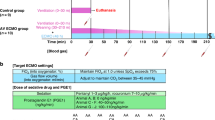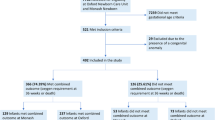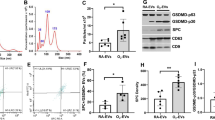Abstract
Background:
Preterm birth and respiratory support with invasive mechanical ventilation frequently leads to bronchopulmonary dysplasia (BPD). A hallmark feature of BPD is alveolar simplification. For our preterm lamb model of BPD, invasive mechanical ventilation is associated with postnatal feeding intolerance (reduced nutrition) and sedation. In contrast, preterm lambs managed by noninvasive support (NIS) have normal alveolar formation, appropriate postnatal nutrition, and require little sedation. We used the latter, positive-outcome group to discriminate the contribution of reduced nutrition vs. sedation on alveolar simplification. We hypothesized that, restricted nutrition, but not sedation with pentobarbital, contributes to impaired indices of alveolar formation in preterm lambs managed by NIS.
Methods:
Preterm lambs managed by NIS for 21d were randomized into three groups: NIS control, NIS plus restricted nutrition, and NIS plus excess sedation with pentobarbital. We quantified morphological and biochemical indices of alveolar formation, as well as mesenchymal cell apoptosis and proliferation.
Results:
Restricted nutrition impaired morphological and biochemical indices of alveolar formation, and reduced mesenchymal cell apoptosis and proliferation. Excess sedation with pentobarbital did not alter these indices, although mesenchymal cell apoptosis was less.
Conclusion:
Our results demonstrate that restricted nutrition, but not excess sedation, contributes to impaired alveolar formation during the evolution of BPD in chronically ventilated preterm lambs.
Similar content being viewed by others
Log in or create a free account to read this content
Gain free access to this article, as well as selected content from this journal and more on nature.com
or
References
Jobe AH. The new bronchopulmonary dysplasia. Curr Opin Pediatr 2011;23:167–72.
Schulzke SM, Pillow JJ. The management of evolving bronchopulmonary dysplasia. Paediatr Respir Rev 2010;11:143–8.
Akram Khan M, Kuzma-O’Reilly B, Brodsky NL, Bhandari V. Site-specific characteristics of infants developing bronchopulmonary dysplasia. J Perinatol 2006;26:428–35.
Bhandari V. Drug therapy trials for the prevention of bronchopulmonary dysplasia: current and future targets. Front Pediatr 2014;2:76.
Jobe AH. What is BPD in 2012 and what will BPD become? Early Hum Dev 2012;88 Suppl 2:S27–8.
Reyburn B, Li M, Metcalfe DB, et al. Nasal ventilation alters mesenchymal cell turnover and improves alveolarization in preterm lambs. Am J Respir Crit Care Med 2008;178:407–18.
Null DM, Alvord J, Leavitt W, et al. High-frequency nasal ventilation for 21 d maintains gas exchange with lower respiratory pressures and promotes alveolarization in preterm lambs. Pediatr Res 2014;75:507–16.
Coalson JJ. Pathology of bronchopulmonary dysplasia. Semin Perinatol 2006;30:179–84.
Albertine KH. Utility of large-animal models of BPD: chronically ventilated preterm lambs. Am J Physiol Lung Cell Mol Physiol 2015;308:L983–L1001.
Stephens BE, Walden RV, Gargus RA, et al. First-week protein and energy intakes are associated with 18-month developmental outcomes in extremely low birth weight infants. Pediatrics 2009;123:1337–43.
Biniwale MA, Ehrenkranz RA. The role of nutrition in the prevention and management of bronchopulmonary dysplasia. Semin Perinatol 2006;30:200–8.
Frank L, Sosenko IR. Undernutrition as a major contributing factor in the pathogenesis of bronchopulmonary dysplasia. Am Rev Respir Dis 1988;138:725–9.
Fanaro S. Feeding intolerance in the preterm infant. Early Hum Dev 2013;89 Suppl 2:S13–20.
Massaro D, Massaro GD, Baras A, Hoffman EP, Clerch LB. Calorie-related rapid onset of alveolar loss, regeneration, and changes in mouse lung gene expression. Am J Physiol Lung Cell Mol Physiol 2004;286:L896–906.
Rehan VK, Sakurai R, Li Y, et al. Effects of maternal food restriction on offspring lung extracellular matrix deposition and long term pulmonary function in an experimental rat model. Pediatr Pulmonol 2012;47:162–71.
Marx CM, Smith PG, Lowrie LH, et al. Optimal sedation of mechanically ventilated pediatric critical care patients. Crit Care Med 1994;22:163–70.
McPherson C. Sedation and analgesia in mechanically ventilated preterm neonates: continue standard of care or experiment? J Pediatr Pharmacol Ther 2012;17:351–64.
Doherty TJ, Andrews FM, Provenza MK, Frazier DL. The effect of sedation on gastric emptying of a liquid marker in ponies. Vet Surg 1999;28:375–9.
Lydon AM, Cooke T, Duggan F, Shorten GD. Delayed postoperative gastric emptying following intrathecal morphine and intrathecal bupivacaine. Can J Anaesth 1999;46:544–9.
Colombato LA, Sabbà C, Polio J, Groszmann RJ. Influence of anesthesia, postanesthetic state, and restraint on superior mesenteric arterial flow in normal rats. Am J Physiol 1991;260(1 Pt 1):G1–6.
Gumbleton M, Nicholls PJ, Taylor G. Differential influence of laboratory anaesthetic regimens upon renal and hepatosplanchnic haemodynamics in the rat. J Pharm Pharmacol 1990;42:693–7.
Hay WW Jr . Strategies for feeding the preterm infant. Neonatology 2008;94:245–54.
Massaro D, Alexander E, Reiland K, Hoffman EP, Massaro GD, Clerch LB. Rapid onset of gene expression in lung, supportive of formation of alveolar septa, induced by refeeding mice after calorie restriction. Am J Physiol Lung Cell Mol Physiol 2007;292:L1313–26.
Joss-Moore L, Carroll T, Yang Y, et al. Intrauterine growth restriction transiently delays alveolar formation and disrupts retinoic acid receptor expression in the lung of female rat pups. Pediatr Res 2013;73:612–20.
Ramel SE, Brown LD, Georgieff MK. The impact of neonatal illness on nutritional requirements-one size does not fit all. Curr Pediatr Rep 2014;2:248–54.
Ehrenkranz RA, Das A, Wrage LA, et al.; Eunice Kennedy Shriver National Institute of Child Health and Human Development Neonatal Research Network. Early nutrition mediates the influence of severity of illness on extremely LBW infants. Pediatr Res 2011;69:522–9.
Ehrenkranz RA. Early, aggressive nutritional management for very low birth weight infants: what is the evidence? Semin Perinatol 2007;31:48–55.
deRegnier RA, Guilbert TW, Mills MM, Georgieff MK. Growth failure and altered body composition are established by one month of age in infants with bronchopulmonary dysplasia. J Nutr 1996;126:168–75.
Wemhöner A, Ortner D, Tschirch E, Strasak A, Rüdiger M. Nutrition of preterm infants in relation to bronchopulmonary dysplasia. BMC Pulm Med 2011;11:7.
Bhandari V, Bergqvist LL, Kronsberg SS, Barton BA, Anand KJ ; NEOPAIN Trial Investigators Group. Morphine administration and short-term pulmonary outcomes among ventilated preterm infants. Pediatrics 2005;116:352–9.
Kim SH, Li M, Pyeon TH, So KY, Kwak SH. The volatile anesthetic sevoflurane attenuates ventilator-induced lung injury through inhibition of ERK1/2 and Akt signal transduction. Korean J Anesthesiol 2015;68:62–9.
Romero A, Moreno A, García J, Sánchez C, Santos M, García J. Effects of sevoflurane on ventilator induced lung injury in a healthy lung experimental model. Rev Esp Anestesiol Reanim 2016;63:22–8.
Frank L, Groseclose E. Oxygen toxicity in newborn rats: the adverse effects of undernutrition. J Appl Physiol Respir Environ Exerc Physiol 1982;53:1248–55.
Martin CR, Dasilva DA, Cluette-Brown JE, et al. Decreased postnatal docosahexaenoic and arachidonic acid blood levels in premature infants are associated with neonatal morbidities. J Pediatr 2011;159:743–749.e1–2.
Joss-Moore LA, Wang Y, Baack ML, et al. IUGR decreases PPARγ and SETD8 Expression in neonatal rat lung and these effects are ameliorated by maternal DHA supplementation. Early Hum Dev 2010;86:785–91.
Albertine KH, Dahl MJ, Gonzales LW, et al. Chronic lung disease in preterm lambs: effect of daily vitamin A treatment on alveolarization. Am J Physiol Lung Cell Mol Physiol 2010;299:L59–72.
Rehan VK, Torday JS. PPARγ signaling mediates the evolution, development, homeostasis, and repair of the lung. PPAR Res 2012;2012:289867.
MacRitchie AN, Albertine KH, Sun J, et al. Reduced endothelial nitric oxide synthase in lungs of chronically ventilated preterm lambs. Am J Physiol Lung Cell Mol Physiol 2001;281:L1011–20.
Acknowledgements
We thank the Division of Neonatology at the University of Utah for support.
Author information
Authors and Affiliations
Corresponding author
Rights and permissions
About this article
Cite this article
Joss-Moore, L., Hagen-Lillevik, S., Yost, C. et al. Alveolar formation is dysregulated by restricted nutrition but not excess sedation in preterm lambs managed by noninvasive support. Pediatr Res 80, 719–728 (2016). https://doi.org/10.1038/pr.2016.143
Received:
Accepted:
Published:
Issue date:
DOI: https://doi.org/10.1038/pr.2016.143
This article is cited by
-
Pilot dose-ranging of rhIGF-1/rhIGFBP-3 in a preterm lamb model of evolving bronchopulmonary dysplasia
Pediatric Research (2023)
-
Dose-dependent impact of human milk feeding on tidal breathing flow-volume loop parameters across the first 2 years of life in extremely low-birth-weight infants: a cohort study
European Journal of Pediatrics (2023)
-
Hippocampal epigenetic and insulin-like growth factor alterations in noninvasive versus invasive mechanical ventilation in preterm lambs
Pediatric Research (2021)
-
Uteroplacental Insufficiency with Hypoxia Upregulates Placental PPARγ-KMT5A Axis in the Rat
Reproductive Sciences (2021)
-
Preterm birth and ventilation decrease surface density of glomerular capillaries in lambs, regardless of postnatal respiratory support mode
Pediatric Research (2017)



